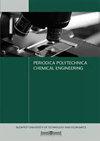Determining the Quintet Lifetimes in Side-ring Substituted [Fe(terpy)2]2+ Complexes
IF 1.8
4区 工程技术
Q3 ENGINEERING, CHEMICAL
引用次数: 0
Abstract
We previously studied the effect of 4' substitution in iron(II)-bis-terpyridine complexes, showing that the photoexcited high-spin quintet-state is stabilized by electron-donating substituents. In this paper we explore the effects of electron-donating ( X = NH2 , Cl ) and withdrawing ( X = NO2 ) substituents in the 5,5" positions on the stability and lifetime of the quintet-state. We used a simple densitiy-functional theory (DFT) based method that had been proven fairly accurate in the case of 4' substitution to estimate the energy barrier of the quintet-singlet transition and thereby predict the quintet state lifetime. We synthetized the complexes and used ultrafast transient optical absorption spectroscopy to experimentally determine the quintet lifetimes, in order to test the applicability of these quantum-chemistry based predictive methods for these side-ring substitution cases. UV-Visible spectra of the complexes have shown that the metal-to-ligand charge transfer (MLCT) and ligand-localized transitions of these complexes change according to the previous observations. We have shown that in the 5,5" positions, electron withdrawing groups stabilize the quintet state, while donating groups destabilize it. This is in stark contrast to the effects previously observed for the 4' case, and indicates that unlike the latter case, the simple concept of inductive and mesomeric effects may not be adequate to describe the changes due to 5,5" substitution, warranting further study of the area.确定侧环取代[Fe(terpy)2]2+配合物中的五重奏寿命
我们以前研究过铁(II)-双叔吡啶配合物中 4'取代基的影响,结果表明光激发的高自旋五元态可通过电子捐赠取代基得到稳定。在本文中,我们探讨了 5,5" 位上的捐电子(X = NH2 , Cl)和析电子(X = NO2)取代基对五元态稳定性和寿命的影响。我们使用了一种简单的基于密度函数理论(DFT)的方法来估算五元子转变的能垒,从而预测五元态的寿命。我们合成了这些复合物,并使用超快瞬态光学吸收光谱实验测定了五元态的寿命,以检验这些基于量子化学的预测方法在这些侧环取代情况下的适用性。复合物的紫外-可见光谱显示,这些复合物的金属-配体电荷转移(MLCT)和配体-局部跃迁与之前的观察结果一致。我们发现,在 5,5 "位置,取电子基团会稳定五元态,而捐电子基团则会破坏五元态的稳定性。这与之前观察到的 4'位置的效应形成了鲜明对比,并表明与后一种情况不同,简单的感应效应和间位效应概念可能不足以描述 5,5 "取代引起的变化,因此有必要对这一领域进行进一步研究。
本文章由计算机程序翻译,如有差异,请以英文原文为准。
求助全文
约1分钟内获得全文
求助全文
来源期刊

Periodica Polytechnica Chemical Engineering
ENGINEERING, CHEMICAL-
CiteScore
3.10
自引率
7.70%
发文量
44
审稿时长
>12 weeks
期刊介绍:
The main scope of the journal is to publish original research articles in the wide field of chemical engineering including environmental and bioengineering.
 求助内容:
求助内容: 应助结果提醒方式:
应助结果提醒方式:


